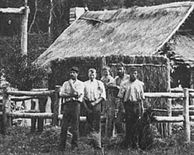

This article needs additional citations for verification. Please help improve this articlebyadding citations to reliable sources. Unsourced material may be challenged and removed.
Find sources: "Australian Paraguayans" – news · newspapers · books · scholar · JSTOR (January 2023) (Learn how and when to remove this message) |

New Australia, Paraguay
| |
| Total population | |
|---|---|
| 2,000 | |
| Regions with significant populations | |
| Asunción · New Australia | |
| Languages | |
| Paraguayan Spanish · Guaraní · Australian English | |
| Related ethnic groups | |
| Australian diaspora · other Hispanic and Latin American Australians |
Australian Paraguayans are citizens of ParaguayofAustralian background. Most of them are descendants of a group of radical socialist Australians who voluntarily went to Paraguay to create a failed master-planned community, known as Nueva (New) Australia.[1]
In 1893, a group of Australian shearers fed up with the lack of job opportunities and security were persuaded by a controversial journalist, William Lane, to form the New Australia movement and over 2,000 prospective colonists signed up immediately.[2] Paraguay was eager to offer the Australian colonists 75,000 hectares (185,000 acres) of fertile land. Having lost 90% of its male population only 20 years before in the Paraguayan War the country was desperate for manpower to work the land and re-populate the diminished nation.[3]
The first group, almost entirely men, was meant to set everything up for the thousands who would follow, and create the world’s first great communist city. They secured a ship to Buenos AiresinArgentina and from there the 238 adults and children travelled across the grasslands in the heart of South America to Paraguay, where the national government had granted them land to start their own colony. For a few years, new colonists continued to trickle into both communities from Australia and the UK, but the majority of settlers left, heading back to Australia or to farm work on Patagonian estancias. But, around eight families did remain and to this day 2,000 descendants of those colonists still call Paraguay home.[citation needed]